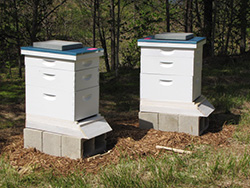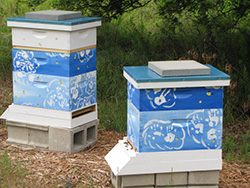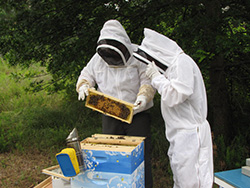Bee Hives Make Appearance on NIEHS and EPA Campus
By Claire Long

Photo courtesy of Bill Willis
June, 2016
On April 16, EPA scientists introduced honey bees and bee hives onto the grounds of the NIEHS and EPA as part of an inter-agency cooperation.
Several of the bee hives were decorated by preschoolers at the First Environments Early Learning Center. The honey bee colonies are part of EPA research activities directed by Dr. David Lehmann and tie into citizen science projects focused on increasing the honey bee population.
“Honey bees are generally not aggressive and only sting as a last resort,” according to NIEHS Environmental Awareness Advisory Committee co-chair Paul Johnson. “Leave them alone and they’ll leave you alone.”

Photo courtesy of Bill Willis
View the video below on what is causing bees to die off, why it’s a problem, and how we can help. For more resources, check out the Bayer Crop Science Bee Care Center in RTP.

Photo courtesy of Bill Willis
Elsewhere in Research Triangle Park, the Research Triangle Foundation installed five honey bee hives this spring as part of their new pollinator garden. This will formally be dedicated at a community event on June 22, 2016 in celebration of National Pollinator Week.
The “Bull City” becomes the “Bee City”!
On June 6, 2016, the Durham City Council unanimously passed a resolution to adopt the practices required to become the nation’s Bee City USA, a designation that marks the commitment of individuals and government agencies to protect and celebrate pollinators.
(Claire Long is a program specialist in the Administrative Services and Analysis Branch)



